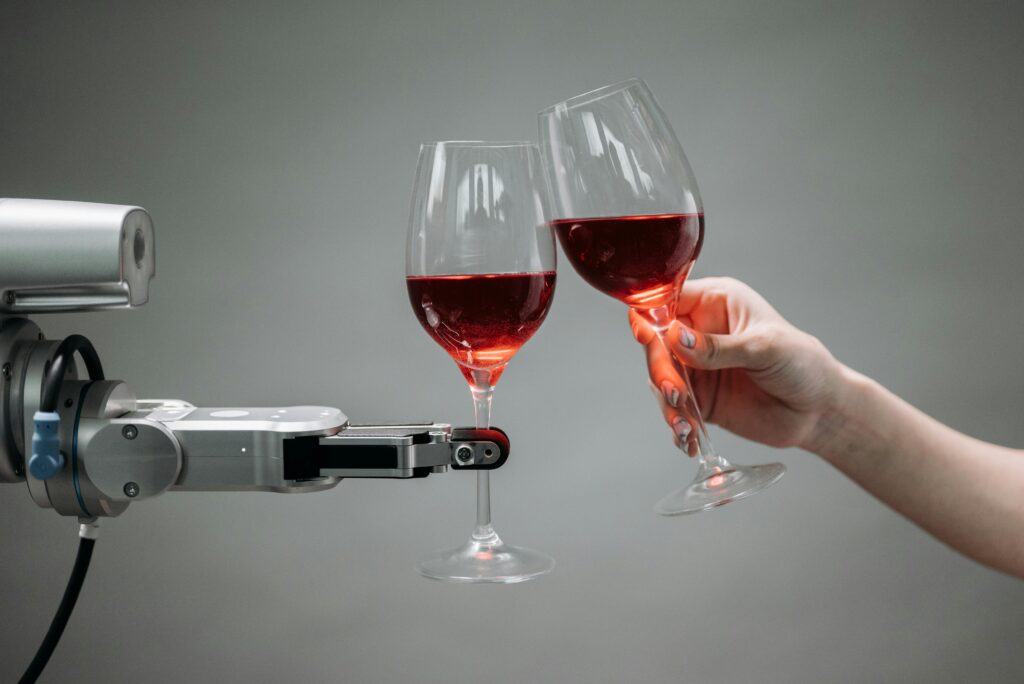Love our content? Show your support by following us — pretty please!🥺
FOLLOW ON PINTEREST
Hi! I’m Kate, the face behind KateFi.com—a blog all about making life easier and more affordable.
Grocery shopping can be one of the most unpredictable parts of your budget. Prices fluctuate, stores run seasonal promotions, and you never really know how much you’re going to spend until you get to the checkout counter. If you’re already juggling rent, utilities, and everyday expenses, it’s easy to feel like you have no control over your food budget.
That’s where artificial intelligence (AI) can make a shocking difference. This powerful technology, once limited to tech giants, is now helping everyday folks like us plan weekly meals, track price changes, and identify the best deals—automatically. In fact, I used a simple AI-based grocery planning tool for one month and managed to cut my weekly bills by 40%. It’s not a gimmick or fad—it’s just a smarter, data-driven way to shop.
Below, you’ll see exactly how AI-powered grocery planning works, why it’s so effective, and how you can easily integrate it into your routine. You don’t need a PhD in computer science or fancy gadgets—just an internet connection, a little curiosity, and the willingness to let a machine do the heavy lifting. By the end of this guide, you’ll be armed with enough tips, examples, and resources to transform your kitchen—and your wallet.
Table of Contents
- Why Groceries Eat Up So Much of Our Budget
- The Rise of AI in Everyday Life
- How AI Tools Are Revolutionizing Grocery Shopping
- Meal Planning Made Easy with AI
- Price Comparison and Real-Time Deals
- Slashing Food Waste: Smart Inventory Tracking
- Combining AI with Coupons and Cashback
- From 40% Savings to Even Bigger Goals
- Success Stories from Real Shoppers
- Common Roadblocks and How to Overcome Them
- Practical Steps to Get Started
- Conclusion
Extended FAQ
1. Why Groceries Eat Up So Much of Our Budget
For many households, groceries rank right behind rent or mortgage payments as a major monthly expense. According to the United States Department of Agriculture (USDA), an average family of four can spend anywhere from $900 to $1,300 a month on groceries, depending on dietary choices and location. Even single adults often see hundreds of dollars vanish on food each month. Why is it so easy for our grocery costs to balloon out of control?
1. Hidden Costs
Little extras—snacks, desserts, or buy-one-get-one deals—end up in the cart even if we’re not sure we’ll use them. Over the course of a month, those items stack up significantly.
2. Lack of Time
When life’s busy, meal planning gets pushed aside. You run into the store on autopilot, leading to random impulse buys. If you’re cooking for a family, the chaos (and the final bill) can multiply.
3. Fluctuating Prices
Food costs are in constant flux. Seasonal produce might be cheap this week and expensive the next. Even staple items like milk and eggs can see price hikes with little warning.
4. Food Waste
According to the Environmental Protection Agency (EPA), Americans waste more than 38 million tons of food each year. Spoiled veggies, forgotten leftovers—throwing away food is literally throwing away money.
5. Frequent Grocery Trips
Every store visit raises the risk of overspending. If you go multiple times a week, the chances of picking up “just one more thing” grow exponentially.
💡 Follow KateFi.com on Pinterest for:
- Frugal living hacks
- Budget-friendly meal ideas
- Creative side hustle tips
- DIY tricks that save you money
If you see yourself in any of these scenarios, you’re not alone. Millions assume that rising grocery bills are just the cost of living. But new AI-driven tools suggest otherwise.
Internal Link: To learn how to restructure other parts of your budget—and free up cash for better groceries—take a look at Stop Living Paycheck to Paycheck: The 21-Day Financial Makeover.
2. The Rise of AI in Everyday Life
Artificial intelligence might sound like an abstract buzzword, but chances are you’re already using it daily. From Google’s autocomplete to Netflix’s show recommendations, AI permeates the digital landscape.
AI’s New Accessibility
A few years ago, AI seemed confined to tech powerhouses in Silicon Valley. Now, startups and established brands offer AI-driven services for free or low-cost. Budgeting apps, language tools, and yes—meal-planning platforms—all harness machine learning to personalize user experiences.
Applications in Personal Finance
AI excels at automating tedious tasks and finding hidden patterns in data. It can help manage everything from debt payoff strategies to credit score hacks. In the grocery realm, AI-based tools analyze price fluctuations, store promotions, and pantry inventory to cut back on overspending.
Internal Link: For a bigger picture of AI’s role in personal finance (beyond groceries), check out The Ultimate 2025 Guide to AI in Finance: How to Transform Your Money with Machine Learning.
3. How AI Tools Are Revolutionizing Grocery Shopping
In the pre-AI world, you’d rely on coupons, store flyers, and memory to navigate grocery costs. AI flips that approach and offers real-time solutions.
Real-Time Pricing
AI-driven grocery apps track the cost of items at various stores simultaneously. If fresh salmon is 30% cheaper at a certain supermarket today, you’ll know. If eggs skyrocket in price, the AI might suggest you switch to another protein source this week.
Big Data Meets Personalization
“Big data” gathers thousands of data points like store sales, seasonal trends, and historical prices. AI cross-references these with your dietary preferences—keto, vegetarian, or family-friendly—to propose the most economical shopping list.
Smart Inventory Tracking
Some advanced setups link with smart kitchen devices or let you manually log pantry items. The AI then keeps track of expiration dates and leftover ingredients, preventing duplication or waste.
External Link: Want to see how companies manage real-time dynamic pricing? Explore Forbes on Real-Time Dynamic Pricing. It’s more retail-focused, but the tech overlaps heavily with how grocery AI algorithms work.
4. Meal Planning Made Easy with AI
Meal planning is the single biggest weapon against grocery overspending—yet it’s notoriously time-consuming. That’s where AI shines.
Step-by-Step AI Meal Planning
- Initial Setup: Input your dietary needs (gluten-free, vegan, family of four) and your target budget.
- Recipe Suggestions: AI cross-references store sales, your pantry, and local produce availability, suggesting budget-friendly meals.
- Auto-Generated Shopping List: You get a detailed list with estimated costs. If an item is on sale, the app highlights it.
- Real-Time Adjustments: If an ingredient becomes too pricey mid-week, the app can swap in a cheaper alternative.
Internal Link: If you need a more comprehensive approach to saving money fast—beyond groceries—check out AI Money Hacks: 10 Genius Tricks to Save $1,000 This Month!. Meal planning is just one of many strategies for boosting your bottom line.
5. Price Comparison and Real-Time Deals
Gone are the days of driving across town to save two bucks on bananas. AI apps do comparison shopping for you, factoring in your time, travel costs, and how each store’s deals stack up.
- Regional Data: These tools pull info from multiple supermarkets in your ZIP code, factoring in loyalty programs.
- App Integrations: If you have a Kroger or Target app, you can sync it with your AI meal planner to apply digital coupons or store rewards automatically.
- Dynamic Alerts: Get a push notification if chicken breasts go on sale for under $2 per pound, so you can stock up or adjust your week’s menu.
External Link: For tips on stacking coupons and deals, see NerdWallet’s Grocery Savings Guide. They explain how to optimize loyalty cards alongside digital coupon clipping—similar tactics your AI app may leverage automatically.
6. Slashing Food Waste: Smart Inventory Tracking
Reducing food waste can save hundreds—if not thousands—over the course of a year. AI can help you track perishables before they spoil.
Expiration Date Alerts
You can log new items as soon as you bring them home. The AI uses typical shelf-life data to warn you when produce is nearing its expiration date.
Meal Revisions
If you have zucchini on its last legs, the AI might swap tonight’s side dish to incorporate that zucchini instead of letting it go to waste.
Repurposing Leftovers
Advanced apps sometimes suggest follow-up recipes to stretch leftovers. Yesterday’s roast chicken becomes tomorrow’s chicken tacos, ensuring every dollar spent goes further.
Internal Link: For conventional (non-AI) tips on cutting grocery costs, you might read 15 Easy Ways to Save Money on Groceries Without Sacrificing Quality. Pairing these traditional hacks with AI-based waste tracking can multiply your savings.
7. Combining AI with Coupons and Cashback
Coupons and cashback aren’t new, but AI changes how you discover and stack these offers.
Automated Coupon Searches
Some AI-driven grocery apps connect to databases of digital coupons, applying the savings automatically at checkout.
Cashback Synergy
Rebate apps—like Ibotta or Fetch—often have item-specific deals. The AI can prioritize those deals in your meal plan if they match your dietary needs, resulting in extra savings.
Card-Linked Offers
Your credit card might rotate categories that earn bonus cashback. If groceries are currently getting 5% back, the AI reminds you to charge your grocery runs to that card.
Internal Link: If you want to explore more ways AI can streamline your finances, check Credit Score Hacks: How to Boost Your Credit Fast Without Paying a Dime. It discusses how leveraging certain credit cards effectively can make a difference in both your score and your savings.
8. From 40% Savings to Even Bigger Goals
Here’s a quick rundown of how I personally slashed my grocery costs by 40%:
- Started AI Meal Planning: A weekly shopping list replaced my haphazard store visits.
- Tapped Into Real-Time Price Tracking: The app subbed cheaper proteins or produce when items suddenly jumped in price.
- Cut Unused Subscriptions: The AI flagged a produce delivery service I’d neglected to cancel, freeing up $30/month.
- Reduced Waste: Expiration alerts kept me from throwing away groceries (and my money).
- Stacked Store Sales with Coupons: Automated coupon searches made it painless to claim savings.
Internal Link: If you’re working on broader financial improvements—like paying off credit card balances—From Debt to Freedom: How AI Can Automate Your Debt Payoff explains how the same technology can also restructure your monthly debt payments.
9. Success Stories from Real Shoppers
It’s not just me. AI-driven grocery planning is a rising trend, and plenty of folks share their experiences in online forums.
- Sarah, Busy Mom of Two: She used to spend $250/week on groceries plus extra on fast-food lunches. After an AI meal planner prompted her to cook at home, she’s saving $400 a month.
- Martin, College Student: On a part-time job budget, he used AI to pinpoint which local store had cheaper veggies. He cut $60/month off his grocery bill—a big deal when you’re on a student income.
- The Andersons, Family of Six: By using a meal planner that prioritizes bulk deals and leftover-based recipes, they save about $200/month.
Internal Link: For a more in-depth experiment, read I Let AI Manage My Budget for 30 Days — Here’s What Happened!. It’s a step-by-step account of how AI oversight can change daily money habits, including grocery spending.
10. Common Roadblocks and How to Overcome Them
Despite the benefits, AI-based grocery shopping has its challenges.
- Learning Curve: Advanced features can feel overwhelming. Start with the basics: meal planning and price comparison.
- Technical Glitches: Apps can crash or have downtime. Keep a basic backup plan (like a short printed list).
- Privacy Concerns: You’ll be sharing location data and maybe scanning receipts. Always read privacy policies and look for reliable reviews.
- Setup Time: Inputting dietary needs and pantry items takes effort initially, but it’s a one-time job that pays off.
- Lifestyle Adjustments: AI might suggest cheaper substitutes you’ve never tried. If you’re open-minded, you can discover new ingredients and save money simultaneously.
Internal Link: If you’re tackling obstacles in other areas of money management, check 5 AI Apps That Predict Your Spending (and Save You Thousands!). It shows how AI can be adapted to different financial goals and personalities.
11. Practical Steps to Get Started
Ready to dive in? Here’s your roadmap:
- Choose Your AI App: Compare reputable grocery or meal-planning tools.
- Enter Your Profile: Number of household members, dietary restrictions, budget.
- Log Existing Pantry Items: Scan barcodes or manually input what you have.
- Generate a Meal Plan: Let the AI suggest recipes. Tweak as needed.
- Review the Shopping List: Note the estimated cost. If it’s high, ask the AI for cheaper swaps.
- Shop and Track: Use the app’s real-time alerts at the store (or online) to see if any last-minute deals pop up.
- Cook and Save: Track leftovers, watch for expiration warnings, and adjust next week’s plan accordingly.
Internal Link: For broader money hacks—including side hustles—see Side Hustles That Work in 2025: The Best Ways to Earn an Extra $2,000 a Month. More income means less stress about groceries in the first place.
12. Conclusion
Groceries can feel like a bottomless pit for your paycheck, but AI technology is rewriting the rules. By automating meal planning, tracking real-time prices, and warning you about potential waste, AI apps arm you with actionable insights you just can’t get on your own—at least not without hours of research and a stack of coupons.
I’ve lived the transformation myself: from throwing together last-minute (and often pricey) grocery runs to following a well-structured AI-based meal plan that cut my bills by nearly 40%. It didn’t require me to become a savvy couponer or stop eating my favorite meals; it just required me to trust the data-driven suggestions the AI provided.
Whether you’re a busy parent, a strapped college student, or someone simply looking to curb expenses, AI is poised to become your new best friend at the supermarket. With a little initial setup and a willingness to embrace tech solutions, you can walk into the store (or click through your online cart) knowing you’re truly maximizing every dollar. And who couldn’t use an extra $100 or more in their pocket each month?
Extended FAQ
Q: Do I need special devices for AI grocery planning?
A: Most AI meal planners are available as web-based platforms or smartphone apps. A basic smartphone or computer with internet access is all you need. Some advanced options integrate with smart fridges or camera-based systems, but that’s optional.
Q: Will AI work with my specific dietary needs (vegan, gluten-free, etc.)?
A: Definitely. Many apps let you specify allergies, dietary restrictions, and personal preferences so the system can filter recipes and deals that match your needs.
Q: How do store loyalty cards and discounts factor in?
A: Popular apps often sync with chain-specific loyalty accounts. The AI automatically calculates in-store discounts, ensuring you see the most accurate estimated price.
Q: What if I prefer curbside pickup or delivery?
A: Most AI-powered meal planners can connect to services like Instacart or Walmart Pickup. You’ll finalize your order online and either schedule a pickup or a doorstep delivery.
Q: Is 40% off my grocery bill a realistic number for everyone?
A: Actual savings vary by region, household size, and dietary habits. Some people see a 20–30% drop, others may exceed 40%. Any level of consistent savings is a win.
Q: Can I apply the same AI approach to other budgets?
A: Yes. AI-driven tools can help with budgeting, side hustles, and even credit improvement. If you’d like to expand beyond groceries, consider reading From Debt to Freedom: How AI Can Automate Your Debt Payoff or The AI Budgeting Blueprint: How to Cut Expenses and Save Like a Pro.
If you’re tired of letting your grocery bill eat away at your hard-earned money, AI is a game-changer. Start simple, follow the app’s suggestions, and watch the savings pile up. Before you know it, that extra cash can go toward debt reduction, emergency funds, or—heck—even a much-needed vacation. Enjoy the new efficiency in your kitchen and in your wallet!





















